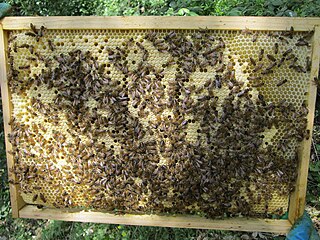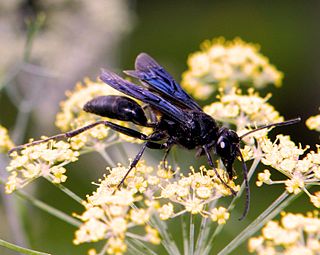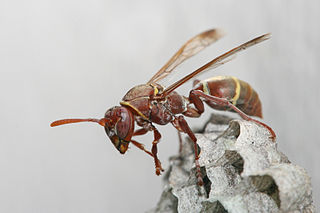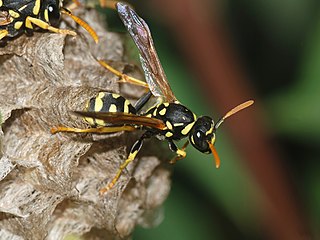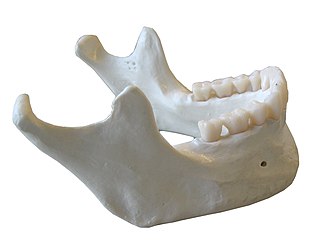
The European paper wasp is one of the most common and well-known species of social wasps in the genus Polistes. Its diet is more diverse than that of most Polistes species—many genera of insects versus mainly caterpillars in other Polistes—giving it superior survival ability compared to other wasp species during a shortage of resources.

Polistes gallicus is a fairly common species of paper wasp found in various parts of Europe, excluding England, Denmark, and Scandinavia, from warmer climates to cooler regions north of the Alps. The distribution of P. gallicus also extends into northern regions of Africa, Israel, Iran, and even parts of China and Russia. Nests of these social insects are created in these various conditions. The Polistes species uses an oral secretion to construct their nests, which consist of a combination of saliva and chewed plant fibers. This structural mixture physically protects the nest from various harsh elements and from weathering over time.

Polistes chinensis is a polistine vespid wasp in the cosmopolitan genus Polistes, and is commonly known as the Asian, Chinese or Japanese paper wasp. It is found in East Asia, in particular China and Japan. The subspecies P. chinensis antennalis is an invasive species in New Zealand, having arrived in 1979.

Polistes annularis is a species of paper wasp which lives throughout the Caribbean and in parts of North America. Its species name is Latin for "ringed" and it is known for its distinct red body color. It builds its nest under overhangs near bodies of water that minimize the amount of sunlight penetration. It clusters its nests together in large aggregations, and consumes nectar and other insects. Its principal predator is the ant, although birds are also known to prey on it. It is a primitively eusocial wasp, meaning that all individuals develop the capacity for reproduction, regardless of social caste. This primitive eusociality has been seen in bees as well, including the sweat bee, Lasioglossum zephyrum. As such, P. annularis demonstrates behavior typical of other polistine wasps, and has a dominance hierarchy, relatively small colony size, and a female-biased sex ratio. Unlike other wasps, P. annularis is relatively robust in winter conditions, and has also been observed to store honey in advance of hibernation. It is closely related to P. major, P. buysonni, and others in the subgenus Aphanilopterus, and slightly less related to the more common P. bellicosus, P. carolina, P. metricus, and P. fuscatus.
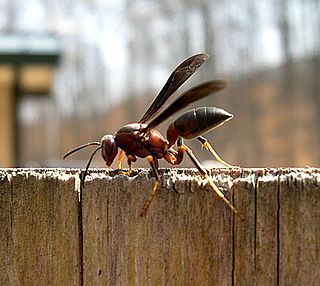
Polistes metricus is a wasp native to North America. In the United States, it ranges throughout the southern Midwest, the South, and as far northeast as New York, but has recently been spotted in southwest Ontario. A single female specimen has also been reported from Dryden, Maine. Polistes metricus is dark colored, with yellow tarsi and black tibia. Nests of Polistes metricus can be found attached to the sides of buildings, trees, and shrubbery.

Polistes fuscatus, whose common name is the golden or northern paper wasp, is widely found throughout southern Canada, the United States, and Central America. It often nests around human development. However, it greatly prefers areas in which wood is readily available for use as nest material, therefore they are also found near and in woodlands and savannas. P. fuscatus is a social wasp that is part of a complex society based around a single dominant queen along with other cofoundresses and a dominance hierarchy.

Polistes exclamans is a social wasp and is part of the family Vespidae of the order Hymenoptera. It is found throughout the United States, Mexico, the Bahamas, Jamaica and parts of Canada. Due to solitary nest founding by queens, P. exclamans has extended its range in the past few decades and now covers the eastern half of the United States, as well as part of the north. This expansion is typically attributed to changing global climate and temperatures. P. exclamans has three specific castes, including males, workers, and queens, but the dominance hierarchy is further distinguished by age. The older the wasp is, the higher it is in ranking within the colony. In most P. exclamans nests, there is one queen who lays all the eggs in the colony. The physiological similarities between the worker and queen castes have led to experiments attempting to distinguish the characteristics of these two castes and how they are determined, though males have easily identifiable physiological characteristics. Since P. exclamans live in relatively small, open combed nests, they are often subject to predators and parasites, such as Chalcoela iphitalis, Elasmus polistis, and birds. P. exclamans have defense and recognition strategies that help protect against these predators and parasites.

One of two types of red paper wasp, Polistes carolina is a species of social wasp in the family Vespidae. They are most commonly found in eastern North America from Texas through Nebraska. The wasp's common name is due to the reddish-brown color of its head and body. Red paper wasps are known to construct some of the largest nests of any wasp species and prefer to build their nests in protected spaces.
Ropalidia fasciata, a common paper wasp, is a wide-ranging species that is distributed from India to the Lesser Sunda Islands, Palawan, and Ryukyu Islands, occupying the northern edge of Ropalidia’s larger distribution. These primitively eusocial wasps are unique in that they do not exhibit the strict matrifilial, single-queen social structure found in many species of social insects. Instead, colonies are founded based on associations between several females, or ‘foundresses.'

Polistes nimpha is a eusocial paper wasp found all over Europe, with particular sightings in Turkey, Finland, Estonia, and Latvia. It is also found in northern Africa, Pakistan, Iran, India, Kazakhstan, Mongolia, and China. The climate in these areas is relatively cold and snowy in the winter, while summers are usually hot and dry, with steppe vegetation. Polistes nimpha colonies are relatively small and easily manipulated.
Polistes canadensis, commonly known as the red paper wasp, is a Neotropical, primitively eusocial wasp. A largely predatory species, it hunts for caterpillar meat to supply its colony, often supplementing its developing larvae with nectar. The most widely distributed American species of the genus Polistes, it colonises multiple combs, which it rears year-round. Emerging from hibernation in the spring, the females found nests built out of plant material such as dry grass and dead wood. These nests are not covered with an envelope and feature hexagonal cells in which eggs are laid and larvae develop. The Polistes canadensis colony divides its colony among several combs and does not reuse these combs as a defense mechanism against parasites such as the tineid moth. A single female queen with, on average, 9.1 foundresses, usually initiates the construction of new combs and cells to form nests. The more foundresses in a colony, the more combs produced. On average, combs grow for 15.4 days and achieve a size of 30.8 cells. One female queen exercises absolute dominance over all other females, often using lateral abdominal vibrations and stroking to suppress the aggressive behavior of her nestmates. While the queen handles all the nest reproduction, the subordinates work to care for, defend, and feed the nest instead. The divisions of labor within the nest correlate with the ages of the red paper wasps. Aside from the female division of labor, male red paper wasps engage in two alternative mating tactics: the role of the territorial male and the role of the patroller. The study of the dominance relations within the Polistes canadensis has provided insight into the social organization that characterizes many social invertebrates.
Polistes atrimandibularis is one of three obligate social parasites among the Polistes wasps found in Europe. Of the three social paper wasp parasites, it is the smallest. It parasitizes multiple species such as P. dominula, P. nimpha, P. associus, P. gallicus, and P. biglumis. Females of P. atrimandibularis are unable to build a nest or produce workers, and therefore rely entirely on the host colony.

Belonogaster petiolata is a species of primitively eusocial wasp that dwells in southern Africa, in temperate or subhumid climate zones. This wasp species has a strong presence in South Africa and has also been seen in northern Johannesburg. Many colonies can be found in caves. The Sterkfontein Caves in South Africa, for example, contain large populations of B. petiolata.

Polistes biglumis is a species of social wasp within Polistes, the most common genus of paper wasp. It is distinguished mainly by its tendency to reside in montane climates in meadows or alpine areas. Selection pressure from the wasp's environment has led to several idiosyncrasies of its behavior and life cycle with respect to its relative species in the genus Polistes. It alone among paper wasps is often polyandrous. In addition, it has a truncated nesting season that gives rise to unique competitive dynamics among females of the species. P. biglumis wasps utilize an odor based recognition system that is the basis for all wasp to wasp interaction of the species. The wasp's life cycle is highly intertwined with that of Polistes atrimandibularis, an obligate social parasite wasp that frequently invades the combs of P. biglumis wasps.
Polistes sulcifer is a species of paper wasp in the genus Polistes that is found in Italy and Croatia. It is one of only three known Polistes obligate social parasites, sometimes referred to as "cuckoo paper wasps", and its host is the congeneric species Polistes dominula. As an obligate social parasite, this species has lost the ability to build nests, and relies on the host workers to raise its brood. P. sulcifer females use brute force, followed by chemical mimicry in order to successfully usurp a host nest and take over as the queen.
Ropalidia plebeiana is a eusocial temperate paper wasp. It is unique, as it is the only temperate wasp in the typically tropical Ropalidia genus. R. plebeiana is widely distributed in eastern Australia, and recently have been found making huge nest aggregations, with thousands of nests on trunks of trees, in south-eastern New South Wales.
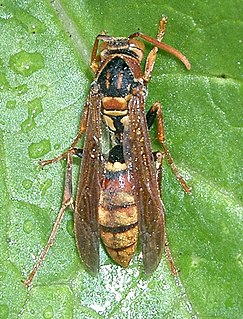
Polistes japonicus is a eusocial paper wasp found in Japan. It was first described by Henri Louis Frédéric de Saussure in 1858. It is closely related to Polistes formosanus. This species lives in small colonies with few workers and a foundress queen. Nests of these wasps are sometimes used as a traditional medicine in Korea, China, and Japan.

Polistes versicolor is a subtropical social wasp within Polistes, the most common genus of paper wasp. The most widely distributed South American wasp species, P. versicolor is particularly common in the Southeastern Brazilian states. This social wasp is commonly referred to as the yellow paper wasp due to the distinct yellow bands found on its thorax and abdomen. The P. versicolor nest, made of chewed vegetable fiber, is typically a single, uncovered comb attached to the substratum by a single petiole. The yellow wasp is frequently found in urban areas. New nests and colonies are usually founded by an association of females, sometimes in human buildings. The P. versicolor colony cycle broadly ranges from 3 to 10 months, although there appears to be no relationship between the colony's development and the season of the year. While yellow paper wasps do have clear annual colony cycles, many young queens have the opportunity to hibernate during the winter, forming optional winter aggregations. Dominance hierarchies within these aggregations are characterized by physical aggression of the dominant female(s) towards the associated females, who tend to be sisters. Wagging movements are also often used as a form of communication within the colony. The yellow paper wasp is generally predatory, capturing a wide range of insects, although it often feeds on pollen and nectar as well. Therefore, P. versicolor can be useful as a pollinator or as effective pest control.
Polistes erythrocephalus is a species of paper wasp in the subfamily Polistinae of family Vespidae found in Central and South America. P. erythrocephalus is a eusocial wasp, meaning that it possesses both reproductive and non-reproductive castes. The cooperation between the two castes to raise young demonstrates the altruistic nature of these wasps. P. erythrocephalus exhibits a four-stage colony cycle, as do many other Polistes wasps. This species generally feeds on larvae, occasionally their own, and is preyed upon by species such as army ants.
